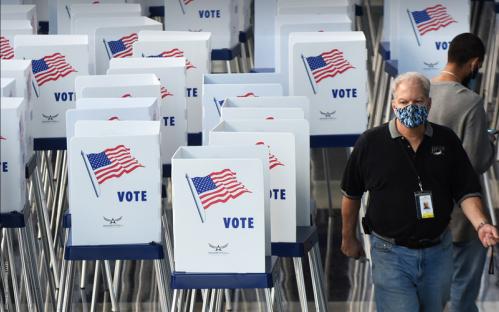In every presidential election since 2004, Americans older than age 45 were the Republican Party’s counterweight to Democratic strength among younger voters. It’s these older voters that kept Republicans competitive in the Electoral College and lead to Donald Trump’s 2016 victory, despite losing the popular vote.
Some see this age imbalance between Democrats and Republicans as inevitable, and even the engine for generating future Democratic wins as older generations age out (see the recent States of Change project report; Ronald Brownstein’s “brown versus gray” voter theory; and my own exposition of the “cultural generation gap”). These prognostications see a continued short-term battle between younger, diverse, and progressive voters who favor Democratic candidates and older voters—whiter and more conservative on social and spending matters—who favor Republicans.
Trump’s embrace of nostalgia, nationalism, and anti-immigrant policies helped him triumph with the older group four years ago, and he is following the same campaign playbook today. Moreover, whites without college degrees (his strongest base) still make up a higher share of older voters than younger voters, both nationally and in key battleground states (Download Table A).
Yet recent polling suggests these older voters—especially seniors age 65 and older—are turning away from Trump, if not Republicans in general. While the long-term impact of their retreat is open to question (since it might be linked to the administration’s handling of the COVID-19 pandemic), it is clear that even a modest shift to challenger Joe Biden on Election Day could lead to solid Democratic wins in most of this cycle’s swing states.
This is evident from a series of simulations of 2020 election results that I conducted for 10 battleground states and the nation as a whole. The simulations look at the differences in voting outcomes that would occur if 2020 voters in broad age groups voted as they did in 2016, or if they follow patterns suggested in recent polls conducted by The New York Times and Siena College. Across the simulations, we see waning Republican support from age groups that were once stalwarts of the party.
The nation’s biggest age blocs shift to Biden
While much attention has been paid to the enthusiasm of young people, millennials, and Gen Z in social and political matters, it remains the case that Americans age 45 and older comprise a plurality of 2020 eligible voters (at 56%) and actual voters (61%), estimated by applying 2016 turnout rates to 2020 eligible voters. The number of seniors—persons age 65 and older—has grown noticeably, as more baby boomers have entered that age bracket. Between 2012 and 2020, seniors’ share of eligible voters rose from 17% to 23%, while their share of actual voters rose from 22% to 26%.

From 2004 through 2016, these older groups showed a preference toward Republican candidates in presidential elections. But in the October 15 to 18 New York Times/Siena College poll, they shifted toward Democrats.
Figure 2 compares Democratic minus Republican (D-R) voting margins for exit polls from the 2012 and 2016 presidential elections as well as the 2020 NYT/Siena poll (adjusted for those who refused to or did not state a preference). Compared with 2012 and 2016, the 2020 poll shows modest gains of 3 and 4 points (from 13% and 14% to 17%) in favor of Democrats for the 18-to-44 age group. But for the 45-to-64 age group, the 2020 poll shows a Democratic swing of 7 and 11 points (from -4% and -8% to 3%) from previous elections. For the 65-and-older age group, the 2020 poll shows a Democratic swing of 23 and 18 points (from -12% and -7% to 11%) from previous elections.

How do these margins translate into actual votes? To assess this, I simulated what would occur if 2020 voters adopted the age group voting patterns of 2012, 2016, and those reported in the 2020 NYT/Siena poll. Not surprisingly, they reveal that the 2020 poll patterns would yield substantially more votes for Democrats, with the two older age groups contributing the greatest gains.

If we assume either 2012 or 2016 voting patterns for 2020, the total net vote nationally would favor Democrats by a razor thin 800,000 votes. In both cases, Democratic gains from the 18-to-44 age group (well over 7 million votes) would be substantially reduced by Republican vote totals for the combined 45-to-64 and 65-and-older age groups (about 6.5 million votes). Assuming the NYT/Siena polling pattern for 2020 voters, however, shows all three age groups contribute to a total net Democratic vote of 14.8 million.
Keep in mind that these are not intended to be predictions of the 2020 national election results. The actual vote patterns will certainly be different than those of 2012, 2016, and the NYT/Siena poll. Rather, the simulations are intended to reveal what would occur if older voters swung markedly from a Republican to a Democratic candidate preference. If that happens, it is clear that Biden would enjoy a far greater popular vote total than if the age group voting patterns from previous elections prevailed.
Seniors in northern swing states have a large say
While the national popular vote provides one perspective, swing states are the key to an Electoral College win. In 2016, Trump’s major victories were due to small vote gains in the northern swing states of Pennsylvania, Michigan, and Wisconsin, as well as somewhat larger gains in Iowa and Ohio. In the first three states, his dominance of older voters was crucial to his success.
This state-specific analysis will compare voting patterns of older voters in the 2016 election (based on exit polls) with those observed in the state-level NYT/Siena polls taken in September and October. This will be followed by simulations of 2020 voting results in these states, assuming these two different sets of voting patterns.

Figure 3 compares D-R margins from the 2016 exit polls and the 2020 NYT/Siena polls for the 45-to-64 and 65-and-older age groups in each of the northern swing states. Across the board, margins for these older age groups become more Democratic. In each state except Ohio, the 65-and-older age group shifts from a Republican margin to a Democratic margin, generally by a large amount. The shift from a Republican to Democratic advantage also occurs for the 45-to-64 age group in Michigan, Wisconsin, and Iowa. And even in Ohio, where older voter groups maintain a Republican margin advantage assuming the 2020 poll, that advantage is smaller than in 2016.
Table 2 displays the simulation results for each northern swing state. In every case, the simulation using 2016 voting patterns yields a net Republican vote advantage, while using the 2020 NYT/Siena polls yields a Democratic advantage. In all cases, the shifts associated the combined 45-to-64 and 65-and-older age groups add the most votes, meaning that the switch to more Democratic-favorable voting choices based on the NYT/Siena polls makes a substantial difference in the direction or size of the Democratic vote gain in that state.

In Michigan, for example, the 2016-based simulation yields net losses to Democrats of 145,119 for the 45-to-64 age group and 50,568 for the 65-and-older groups. This shifts to net Democratic gains of 19,298 and 180,599 for these two age groups when assuming the voting patterns of the NYT/Siena poll. Together, this results in a net shift of 395,583 votes to Democrats.
In Ohio, where older age groups voted Republican in both scenarios, the lower Republican net gain in the NYT/Sienna-based scenario allows Democratic gains from the 18-to-44 age group to win the state.
All of these states show greater net Democratic contributions from the 18-to-44 age group in the NYT/Siena-based scenario (See downloadable Table A). Yet the shift toward Biden among older voters in that scenario contributes to a more convincing Democratic vote gain in each northern swing state.
Older voters in West and South swing states are less favorable to Trump
Five swing states in the West and South—Arizona, Florida, North Carolina, Georgia, and Texas—display somewhat different voting pattern shifts among their older populations. Arizona mostly follows the “northern” model, wherein older voters switch from Republican margins using the 2016-based scenario to Democratic margins using the NYT/Siena-based scenario. In the other states, older voters continue to vote Republican, but less so in the NYT/Siena-based scenario. Nonetheless, this aids the Democratic cause, as the simulations below show.


Figure 4 shows that each state except Texas shifts from a net Republican vote advantage under the 2016-based simulation to a Democratic advantage under the NYT/Siena-based simulation.
Older voters’ Democratic shift most strongly impacts Arizona. The 2016-based Republican vote advantage of 259,000 for the combined 45-to-64 and 65-and-older age groups shifts to a Democratic advantage of 127,000 votes in the NYT/Siena-based simulation. Were it not for this shift, Arizona would show Republican gains in the 2020 simulation.
In Florida, too, the smaller Republican advantage among older voters in the NYT/Siena-based simulation helps to power a net Democratic vote gain. The shift in these older age groups is largely responsible for turning a 430,000 statewide Republican gain in the 2016-based simulation to a 542,000 Democratic gain in the NYT/Siena-based simulation.
The same can be said for North Carolina and Georgia. In both states, substantially lower Republican voting by older voters converts these very close swing states from Republican to Democratic net vote gains.
Texas appears to be the outlier of these five states. While both of its older age groups vote less Republican in the NYT/Siena-based simulation, the under-45 age group did not increase its Democratic vote enough to turn the Lone Star State blue. Still, the net Republican vote advantage is more than halved, from 1.2 million in the 2016-based simulation to barely over 500,000 in the NYT/Siena-based simulation.
What it means for Election Day
If recent polls such as the NYT/Siena survey accurately predict the voting patterns of older age groups on November 3, there is little doubt that there would be a strong Biden and perhaps Democratic-wide sweep in most (if not all) of the 10 swing states examined here.
Up to this point, older Americans—especially seniors—have been the only voting bloc that Trump and other Republicans could reliably count on. A dramatic switch in their voting patterns, as projected here, would likely prompt another Republican autopsy of their election loss, like the one issued after the party’s 2012 defeat. This time, however, they will be forced to reckon with the twin issues of how to attract votes from both the young and the old.
The Brookings Institution is committed to quality, independence, and impact.
We are supported by a diverse array of funders. In line with our values and policies, each Brookings publication represents the sole views of its author(s).






Commentary
Older voters may secure a Biden victory in 2020’s swing states
October 28, 2020